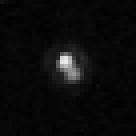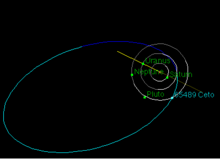65489 Ceto
65489 Ceto, as a binary also (65489) Ceto/Phorcys,[4] is a binary trans-Neptunian object (TNO) discovered on March 22, 2003 by Chad A. Trujillo and Michael Brown at Palomar. It is named after the sea goddess Ceto from Greek mythology. It came to perihelion in 1989.[2]
 Hubble Space Telescope image of Ceto and Phorcys, taken in 2006 | |
| Discovery | |
|---|---|
| Discovered by | C. A. Trujillo and M. Brown |
| Discovery site | Palomar |
| Discovery date | 22 March 2003 |
| Designations | |
| (65489) Ceto | |
| Pronunciation | /ˈsiːtoʊ/ |
Named after | Ceto |
| 2003 FX128 | |
| TNO Centaur–extended[1] | |
| Adjectives | Cetoan /siːˈtoʊən/ or Cetoian /siːˈtoʊ.iən/ |
| Orbital characteristics[2] | |
| Epoch 13 January 2016 (JD 2457400.5) | |
| Uncertainty parameter 2 | |
| Observation arc | 9239 days (25.30 yr) |
| Aphelion | 187.74 AU (28.086 Tm) |
| Perihelion | 17.8498 AU (2.67029 Tm) |
| 102.79 AU (15.377 Tm) | |
| Eccentricity | 0.82635 |
| 1042.22 yr (380669.7 d) | |
| 9.1219° | |
| 0.00094570°/day | |
| Inclination | 22.266° |
| 171.85° | |
| 320.086° | |
| Known satellites | Phorcys /ˈfɔːrsɪs/ (171±10[3] ~ 132+6 −14 km[4] in diameter) |
| Earth MOID | 16.895 AU (2.5275 Tm) |
| Jupiter MOID | 12.7433 AU (1.90637 Tm) |
| Physical characteristics | |
| Dimensions | 223±10 km[3] 174+16 −18 km[4] |
| Mass | (5.4±0.4)×1018 kg (system)[4] |
Mean density | 1.37 g/cm3 (system)[4] |
Equatorial surface gravity | 3.3 cm/s2[4] |
| 4.43 h (0.185 d) | |
| 0.056±0.006[3] 0.084±0.02[4] | |
| 6.54±0.06,[3] 6.4[2] | |
Physical characteristics

65489 Ceto is an example of a close binary TNO system in which the components are of similar size. Combined observations with the infrared Spitzer Space Telescope and the Hubble Telescope allow the diameter of Ceto itself to be estimated at 174+16
−18 km and the diameter of Phorcys at 132+6
−14 km, assuming equal albedo for both components.[4]
The binary nature of Ceto enables direct calculation of the system mass, allowing estimation of the masses of the components and providing additional constraints on their composition. The estimated density of Ceto is 1.37+0.66
−0.32 g/cm3, significantly less than that of the large TNOs (Haumea: 3.0 g/cm3, Eris: 2.26, Pluto: 2.03, Charon: 1.65) but significantly more than that of smaller TNOs (e.g. 0.7 g/cm3 for (26308) 1998 SM165). Phorcys has a mass of about 1.67×1018 kg.[4] Unless the bodies are porous, the density is consistent with rock–ice composition, with rock content around 50%.[4]
It has been suggested that tidal forces, together with other potential heat sources (e.g. collisions or 26Al decay) might have raised the temperature sufficiently to crystallise amorphous ice and reduce the void space inside the object. The same tidal forces could be responsible for the quasi-circular orbits of the components of Ceto.[4]
Ceto is listed on Michael Brown's website as possibly a dwarf planet.[5]
Satellite
| Discovery | |
|---|---|
| Discovered by | Keith S. Noll et al. |
| Discovery date | 2006 April 11 |
| Designations | |
| Pronunciation | /ˈfɔːrsɪs/ |
Named after | Phorcys |
| (65849) Ceto I Phorcys | |
| Adjectives | Phorcynian /fɔːrˈsɪniən/,[6] Phorcyan /ˈfɔːrsiən/[7] [8] |
| Orbital characteristics | |
| Satellite of | Ceto |
| Physical characteristics[9] | |
| Dimensions | 171±10[3] 132+6 −14 km.[4] primary/secondary ratio 0.76±0.01 |
| ΔM = 0.56±0.03 | |
Ceto's satellite was identified as a binary on April 11, 2006 by K. Noll, H. Levison, W. Grundy and D. Stephens using the Hubble Space Telescope; the object was named Phorcys, formally (65849) Ceto I Phorcys, after the Greek sea god. Using an extended definition of a centaur as an object on a non-resonant (unstable) orbit with its perihelion inside the orbit of Neptune,[10] the Ceto system can be considered the second known binary centaur.[4]
Phorcys's diameter has been estimated to be 171±10[3] and 132+6
−14 km.[4]
See also
References
- Marc W. Buie (2006-05-05). "Orbit Fit and Astrometric record for 65489". SwRI (Space Science Department). Retrieved 2009-01-25.
- "JPL Small-Body Database Browser: 65489 Ceto (2003 FX128)" (2006-05-05 last obs). Retrieved 25 March 2016.
- Santos-Sanz, P., Lellouch, E., Fornasier, S., Kiss, C., Pal, A., Müller, T. G., Vilenius, E., Stansberry, J., Mommert, M., Delsanti, A., Mueller, M., Peixinho, N., Henry, F., Ortiz, J. L., Thirouin, A., Protopapa, S., Duffard, R., Szalai, N., Lim, T., Ejeta, C., Hartogh, P., Harris, A. W., & Rengel, M. (2012). “TNOs are Cool”: A Survey of the Transneptunian Region IV - Size/albedo characterization of 15 scattered disk and detached objects observed with Herschel Space Observatory-PACS
- Grundy, W.M.; Stansberry, J.A.; Noll K.S.; Stephens, D.C.; et al. (2007). "The orbit, mass, size, albedo, and density of (65489) Ceto/Phorcys: A tidally-evolved binary Centaur". Icarus. 191: 286. arXiv:0704.1523. Bibcode:2007Icar..191..286G. doi:10.1016/j.icarus.2007.04.004.
- Michael E. Brown. "How many dwarf planets are there in the outer solar system? (updates daily)". California Institute of Technology. Archived from the original on 2011-10-18. Retrieved 2015-10-03.
- Origin of the Homeric Poems, in The Quarterly Review, vol. LXXXVII, Jan. 1831, p. 164
- Henry Tytler (1828) Punics of Caius Silius Italicus, vol. 1, p. 48 [with the stress on the first syllable, consistent with the short 'y' in Greek and Latin]
- The form Phorcian is also found, but derives from the assimilated Latin Phorcus / Phorci rather than Phorcys / Phorcyos.
- Johnston's Archive
- J. L. Elliot; S. D. Kern; K. B. Clancy; A. A. S. Gulbis; R. L. Millis; M. W. Buie; L. H. Wasserman; E. I. Chiang; A. B. Jordan; D. E. Trilling & K. J. Meech (February 2005). "The Deep Ecliptic Survey: A Search for Kuiper Belt Objects and Centaurs. II. Dynamical Classification, the Kuiper Belt Plane, and the Core Population" (PDF). The Astronomical Journal. 129: 1117. Bibcode:2005AJ....129.1117E. doi:10.1086/427395.
External links
- Binary asteroids at johnstonsarchive
- 65489 Ceto at the JPL Small-Body Database